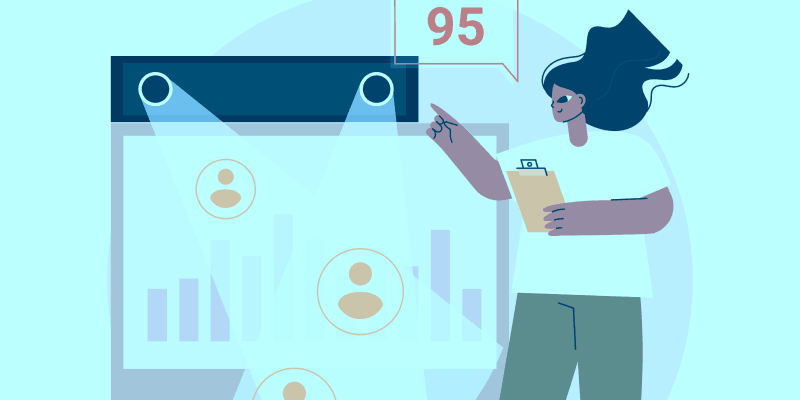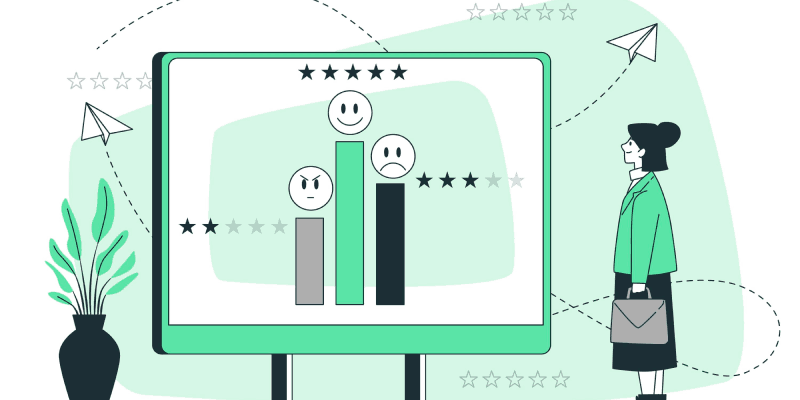Guide to Calculating Customer Health Scores

Calculating customer health scores is a necessary (and transformative) step in building a strong Customer Success program for Software-as-a-Service (SaaS) companies. Below I review what health scoring in SaaS is all about and identify the variables you should consider when building your customer health scoring model.
What is Customer Health Scoring?
A customer health score is more than just a numerical representation of the customer’s satisfaction with your product. It is a tool we use to measure the success of the relationship between us, our customers, and our software.
It strives to answer several questions in a single number:
- Are our customers achieving their goals with the platform?
- Are we getting what we hoped from the relationship?
- Will our customers renew their contract (or even expand their investment in our solution)?
- Are our customers likely to churn?
This is a lot of insight to expect from one number (which is why thought leaders in the industry are looking to re-evaluate health scoring).
What Should a Customer Health Score Look Like?
You might begin with a “Red, Yellow, Green” or “Traffic Light” system. Over time though, you will want to move to a Customer Health Score calculated by a specific Customer Success/Business Intelligence application: a multi-input algorithm that monitors real-time behavior.
Once you reach a certain scale, measuring health intuitively based on personal relationships is no longer realistic, which is when you need data analytics to take some of the burden for this.
Industry body, the Technology Services Industry Association’s Land, Adopt, Expand, Renew (LAER) strategy advises that we approach health scores using the ‘Categorize, Weigh, and Measure’ methodology. We should:
- Categorize the required data sets;
- Weigh the relative importance of the different inputs; and finally
- Measure and build a workflow infrastructure to manage risk and opportunity indications.
There are a number of things to consider when deciding if and how to measure Customer Health. For the health number to be an effective KPI, you will need to take into consideration multiple data types and sources. You will also need to apply weight to the different inputs to reflect their importance within the overall score. If your score is to be auto-generated, should you add a manual, subjective component to the score to reflect human intuition?
You will need to decide what your ‘scale’ should be. Will you use a 1-100 range or a custom range that reflects your specific use case? A traffic light score? Emoji?
What will levels or thresholds within that scale indicate? 10 out of 100 sounds low but is it low on my scale? What do different ranges within the scoring indicate and what do they imply about my client? Are they at risk of churn? Is there an opportunity for upsell? are they a potential reference customer?
You will need to decide whether a single health score is enough? You may find that you need to calculate scores differently for different customer segments. For instance, customers may behave very differently during onboarding than during renewal or you may have different product lines that users engage with very differently. In these different scenarios, health scores should potentially include different components, weighted differently. To further complicate matters, you may need to apply multiple scores to each individual customer or apply scores directly to your end-users and roll them up into a single, unifying Customer score!
Ideally, we are looking for a means to maximize Customer Lifetime Value (CLV). To help with that a health score should be not just an indicator of past or current health, but a means by which to predict future behavior. It should help us understand what we need to do to maximise CLV and when we need to do it.
Recent work by Lincoln Murphy around “Success Vectors” is leading Customer Success professionals to think more strategically about how measurements like health scoring can help predict future customer behavior and ultimately forecast future revenues based on past behaviors.
How cool would it be for SaaS CEOs and CFOs to be able to easily and accurately forecast expansion revenues for a particular cohort based on a set of set of behaviors within a health score!
How Implementing an Accurate Health Scoring System Can Benefit Your Business
Keeping an accurate health score will allow your company forecast renewal revenues more accurately. This will be key to your success as your SaaS business grows and renewals outgrow new business as the largest revenue stream. Planning for growth is made much easier when forecasted revenues match realized revenues. Building a predictive element into your score will mean you should know when a customer will hit a success milestone and thus expand/add-on. Rolling this up, you can predict what kind of ARR expansion you should expect from a particular ‘health score’ cohort. Again, this will allow for tighter forecasting accuracy.
Implementing a successful scoring system will mean:
- CSMs can identify which customers are in need of help and/or at risk of churn
- CSMs can identify which customers to dedicate sales resources to i.e. who are the targets for expansion
- Territories can be more fairly balanced with an effective scoring model. ‘Problem’ and ‘expansion opportunity’ accounts can be shared more equally across the team.
- You can identify where intervention by Customer Success, Support or Marketing have had an effect. This makes it easier to measure the ROI of these resources and more effectively deploy them going forward.
- Building a predictive element into your score will mean you should know when a customer will hit a success milestone and thus expand/add-on. Rolling this up, you can predict what kind of ARR expansion you should expect from a particular ‘health score’ cohort.
The Limitations of Health Scoring
Traditional health scoring systems have generally been seen to be problematic and often leave a CSM or account manager saying ‘so what’ or ‘what now’? Some of the problems include:
- Manual/Labour Intensive
- Without access to a Customer Success platform that facilitates the real-time integration of data-inputs and calculation of a real-time score, CSMs have been burdened with trying to use Excel or a BI tool to calculate the score and then update the CRM. This also means the score is…
- Out of date
- It’s probably better to dedicate your energies to acquiring real-time data than building strategy around old data. You can’t expect new results with old data.
- Lagging indicator
- Again, a traditional score is based on old data. What we’re looking for is a score based on fresh data that indicates potential future behavior, a leading indicator. We can build strategy and trigger activities from that type of score.
- Inaccurate
- The reliance on legacy data and human input has meant that health score data has historically been unreliable.
- Subjective
- Too much weight has been given to CSM or rep intuition. This can have a positive impact on the score in an ultra-high-touch scenario but once an element of scale is introduced a mode automated approach is required.
- Short on detail
- Traditional scoring may not give insight into WHY the customer is healthy or not. This makes the scheduling of mitigating steps difficult.
- Ultimately traditional health scoring can be an unreliable source of data on which to base any kind of engagement strategy.
What we need is a dynamic real-time score, aligned to reflect the health of specific segments of customers. A score built from all relevant customer data, integrated in real-time and weighted to reflect its relative significance to that particular customer segment. The score should facilitate the triggering of actions either from changes in the high-level score itself or from changes or trends within the subsets of data that it is compiled from.
The Components of an Effective Health Score
The data inputs you use should help measure the success or failure of desired outcomes, both yours and the customers’. You are, of course, bound by the data that you have access to and any data isn’t necessarily better than no data. e.g.
- If you can only access ‘platform usage’ data via a monthly CSV export run by your developers, you may be working from old, potentially misleading data. Obviously, using real-time data via tracking codes or an API is preferable.
- A high number of support tickets opened within a specific period may be weighted negatively within a health score. However, if you have more data showing tickets are being resolved satisfactorily, this may indicate your customer is fully exploring the application and could, in fact, be an indication of positive health.
Here is a list of data inputs you may consider using within your health score:
- Use of your solution:
- Daily login rates
- Events (creation of records/activities etc)
- License activation
- Use of ‘sticky’ features
- Depth of use
- Breadth of use
- # of Renewals
- Expansion ($ value and # of upsells)
- Revenue Churn (via reduced licenses or discounting)
- Spend on non-recurring items (training, consultancy etc)
- Support tickets, consider:
- # open
- severity
- positively resolved
- negatively resolved
- average resolution times
- Billing history (unpaid invoices, delays in payment etc)
- Length of time as a customer
- Length of Time to First Value (TTfV)
- Marketing involvement (webinars/conferences attended, whitepapers downloaded etc)
- Survey information (CSAT, NPS etc)
- Executive relationship (c-suite users, calls/emails with c-suite etc)
- Advocacy (are they giving references/referrals)
- Customer corporate profile (company growing/hiring, profit warning/redundancies etc)
- Outcomes (have they hit ‘success goals’)
- Engagement – volume of messaging, calls, email etc
- Community Engagement (portal, groups)
- Social media engagement (content retweets, likes, comments etc)
- CSM intuitive feedback (give your employees scope to influence the score after each engagement)
It’s (very) unlikely you will want to include all of the above. You will need to sanity check the scoring and weightings on a regular basis (e.g. after a product/pricing change) and that will prove very challenging with too much complexity.
Also, in the case of a major movement in health score, you will need to be able to easily drill in and identify the root cause is without too much difficulty
Implementing an Automated Scoring System
Most companies “dip their toes” into Health Scoring by assembling one or more Excel files. This solution can be surprisingly powerful and can incorporate any number of different score components. In time though, the work required to regularly move data into this file can become burdensome. At this point, a full-fledged Customer Success Management tool is much better suited, one that can help your business:
- Grow adoption
- Minimize churn
- Maximize expansion
- Maximize CLV
There are a number of solutions on the market that will allow you to integrate the customer data from your business applications and the usage data from your own software platform. The first step is to evaluate which of these platforms is capable of integrating the business applications you are using. Can you create a direct connection to your application via an API (if not, you may have to arrange a regular export of usage data from the back end of your platform and import to the CS application (unwieldy but better than nothing) usage data is key in providing the insights required for building an effective health score).
Once the data has been integrated, the best CS apps will allow you to use point and click functionality to combine and weight your data sets to produce a bespoke health score for either all of your customers or multiple health scores for different customer segments.
Once you have that dynamic health score in place, a good CS application with allow you to build automatic alerts and use automated customer success playbooks that will advise the CSM when and how to intervene to prevent churn, increase adoption and sell more or will engage directly with the client via automated messaging.
Once you are set up you can start to use the health scoring to:
- Balance territories based on health or allocate CSM resource appropriately i.e. A CSM sub-team with more technical skills can manage customers with low health and a training need. Another team with better sales skills can be aligned with high health upsell targets,
- Use cohort and trend analysis to track the impact of the CS team,
- Continually refine health scoring by correlating it with real-world outcomes.
Customer health scores are a powerful tool that should be used in a Customer Success program. When properly set up and managed through an automated tool, they can greatly improve the efficiency and effectiveness of your team.








